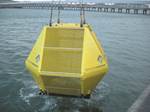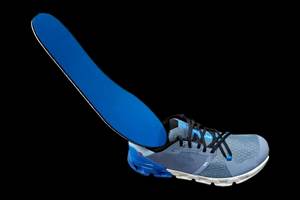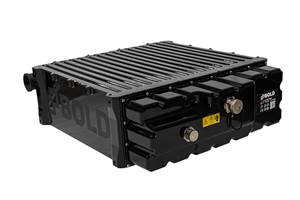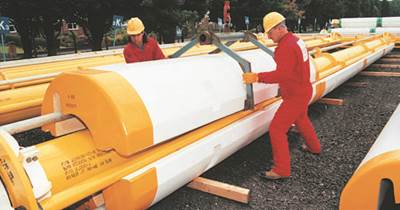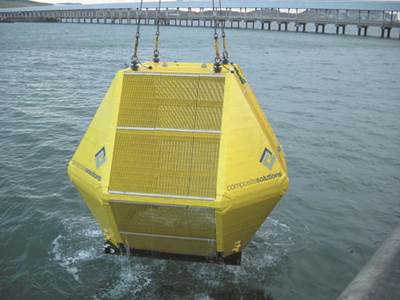Riser Arch Trays, Mud Mats Provide Multiple Benefits
In 1999, 42 composite riser arch trays were supplied by DML Composites (Plymouth, U.K.) to Halliburton Subsea for the Norsk Hydro Troll C field riser support system, in 1,100 ft/340m of water. The trays, which sit atop two 260 ft/80m tall steel jacket riser support structures, cradle the flexible risers that c
In 1999, 42 composite riser arch trays were supplied by DML Composites (Plymouth, U.K.) to Halliburton Subsea for the Norsk Hydro Troll C field riser support system, in 1,100 ft/340m of water. The trays, which sit atop two 260 ft/80m tall steel jacket riser support structures, cradle the flexible risers that connect the subsea wellheads to the floating production unit above, controlling riser bend radius. The segment of the riser suspended between the tray and the platform exerts high dynamic loads, and the segment between the tray and the sea floor exerts high static loads, necessitating a robust tray design.
The trays consist of two curved sections with a flat portion in the center. Tray Type I was designed for 8 inch diameter risers, with two 13 ft/4m radii and a 9.75 ft/3m center flat section; Type II trays for 10 inch risers have two 19.5 ft/6m radii and a 9 ft/2.8m center section. A slot molded into each center section is designed to receive the flange of the riser string.
No general standards for composite design and construction were available at the time, so the trays were designed in accordance with composite best practice and DML’s internal guides. Design factors were based on relevant offshore standards and long-term composite degradation tests carried out on British Royal Navy mine-hunter vessels that are made with materials similar to those selected for the trays. Samples taken from the vessels over a 25-year lifetime showed a net reduction in tensile strength of 39 percent. Based on the Royal Navy data, the company designed in a 0.54 knockdown factor to account for degradation.
On behalf of Norsk Hydro, Det Norske Veritas (DNV) carried out a third -party verification of the design, using a statistical failure approach that has since been incorporated into the DNV guideline DNVOS- C501 “Composite Structures” (see Sidebar). Stresses in the structure were analyzed using finite element analysis (FEA) techniques and compared against the design allowables. An aggressive design life of 250 years was adopted, given the inaccessibility of the structure and its critical function.
While carbon/epoxy and glass prepregs were considered, DML ultimately selected E-glass quadraxial and unidirectional stitched fabrics and Scott Bader (Wollaston, Northamptonshire, U.K.) isophthalic polyester resin. The curved shell that supports the riser in service was formed separately from the beam that supports the shell and provides the connection to the steel support tower.
Buildups for added strength in specific areas were achieved by orienting additional plies of the quadraxial and unidirectional fabrics at 90° to the principal plies. “While cored solutions were also considered, there was concern that simple cores might collapse due to hydrostatic pressure,” says Hill.
After room-temperature cure, the shell was laminated to the beam using the same Scott Bader resin, and the entire assembled structure was post-cured. The beam and the center, flat section of the shell act together as a box beam to resist the applied loads and torsional moments.
Completed trays were shipped to the fabrication yard in Nig, Scotland. Each was attached to a steel supporting truss with a steel plate and eight bolts. The trusses were then attached to the steel jacket towers and barged to the North Sea site in April 1999. No problems have been observed since the trays have been in service.
More recently, Vosper Thornycroft’s Composite Technology Centre (Woolston, Southhampton, U.K.) was awarded a contract for a set of four mud mats for a large jacket to be located in the Caspian Sea. Composite material was specified to reduce load on the jacket’s cathodic protection system and reduce total system weight. The 120-ft/33m by 88-ft/24m mats will be hand layed up with woven fiberglass and polyester resin, with unidirectional glass tape used for buildups around flanges and stiffeners. Kenny Dunn of Vosper Thornycroft says the project, scheduled for completion in 2003, is the first use of composites for mud mats and that total composite weight will exceed 176 tons/160 tonnes.
Related Content
Running shoe insoles get a lift with thermoplastic fiberglass tapes
FlexSpring insoles take advantage of unidirectional, continuous fiberglass and thermoplastics to enable next-level performance for the everyday runner.
Read MoreCirculinQ: Glass fiber, recycled plastic turn paving into climate solutions
Durable, modular paving system from recycled composite filters, collects, infiltrates stormwater to reduce flooding and recharge local aquifers.
Read MoreAviation-specific battery system uses advanced composites to address electric, hybrid flight
BOLDair’s composite enclosure, compression structures and thermal runaway management enables high-performance electric energy storage.
Read MoreAl Seer Marine, Abu Dhabi Maritime unveil world’s largest 3D-printed boat
Holding the new Guinness World Record at 11.98 meters, the 3D-printed composite water taxi used a CEAD Flexbot to print two hulls in less than 12 days.
Read MoreRead Next
Composites Air Cans Lighten Riser Loads
Low-pressure air cans, designed to add buoyancy to a spar platform’s riser string, are good candidates for composite materials. Up to 12 ft/3.7m in diameter and from 30 to 60 ft/9.2 to 18.5m long, the hollow structures support the riser weight and take load off of the platform’s hull. Typically installed insid
Read MoreDesign Issues With Subsea And Downhole Components
For structures below the water line and in the borehole, composites add to their list of benefits the key characteristic of design flexibility, because composite materials can be tailored to meet specific challenges. For example, composites can add buoyancy to low-pressure steel air cans on a spar platform’s r
Read More

